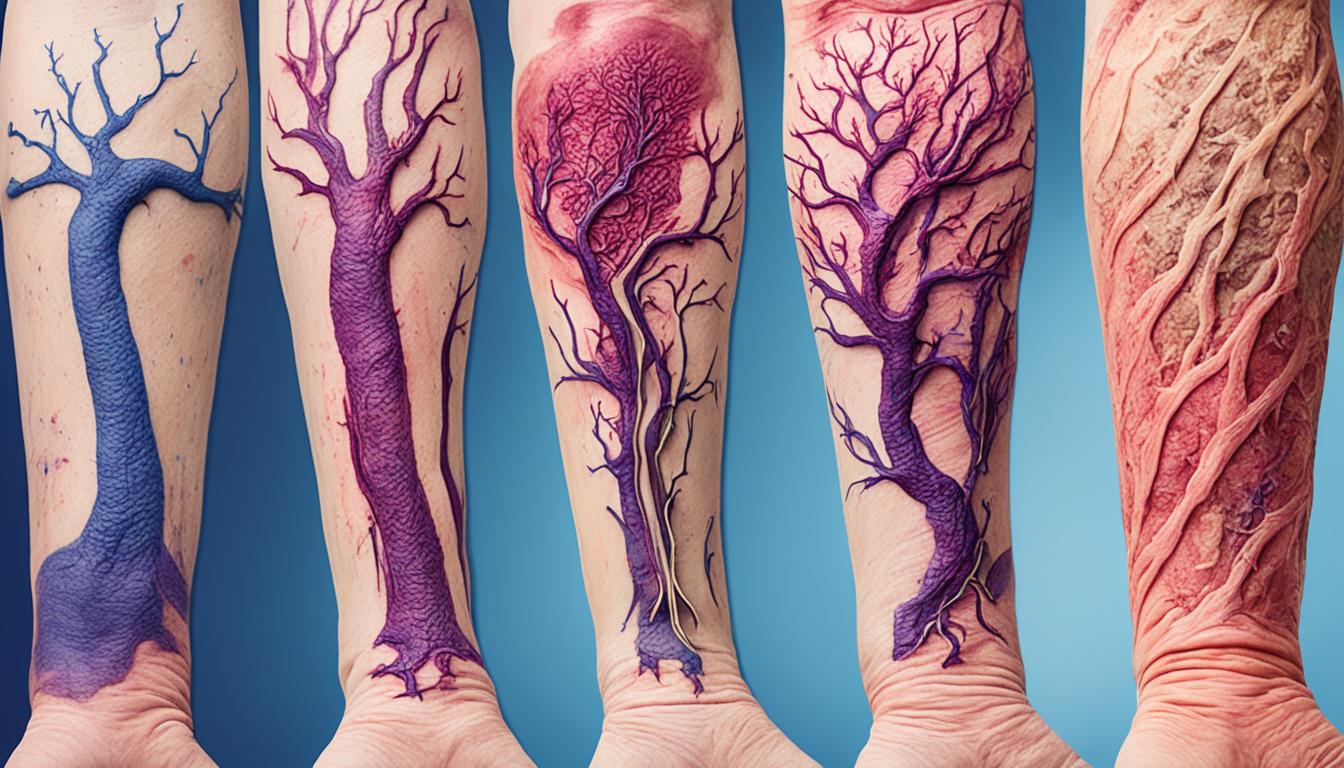Klippel-Trenaunay syndrome (KTS) is a rare condition that affects the blood vessels. It leads to malformations such as capillary, venous, and lymphatic malformations. This disorder starts early in life and impacts both boys and girls the same. Its exact causes are a mix of genetic and environmental factors.
Doctors diagnose Klippel-Trenaunay syndrome by looking at the patient’s symptoms. These include skin issues and one limb being larger than the other. Tests like Doppler ultrasound and MRI help confirm the disease and its severity. Even though there’s no cure, a team of specialists can help manage the symptoms and problems it causes.
Using stem cells to treat KTS is a new approach that holds great hope. Scientists are working on new methods to make life better for those with this syndrome.
Key Takeaways:
- Klippel-Trenaunay syndrome is a rare vascular disorder characterized by various vascular malformations.
- It typically presents during childhood and affects both males and females equally.
- The exact cause of KTS is still unknown, but genetic and environmental factors play a role in its development.
- Diagnosis is based on clinical manifestations and imaging studies.
- Management involves a multidisciplinary approach to address symptoms and complications.
- Stem cell therapy holds promise as a future treatment option for KTS.
Symptoms and complications of Klippel-Trenaunay syndrome
Klippel-Trenaunay Syndrome (KTS) is a rare vascular disorder. It shows a variety of symptoms and complications. It’s key to know about these to effectively treat the condition.
People with KTS might have:
- Port-wine stains or other birthmarks.
- Limb overgrowth or undergrowth.
- Varicose veins.
- Swelling called lymphedema.
- Abnormal growth of soft tissue and bone.
KTS also brings risks such as:
- Bleeding that keeps happening.
- Infections.
- Blood clots in deep veins (DVT).
- Gastrointestinal bleeding.
Doctors focus on managing these issues and easing the symptoms. Approach can involve:
- Using compression to improve blood flow and lessen swelling.
- Don’t forget pain and swelling meds.
- Having surgeries to fix vein problems or limb differences.
Folks with KTS need to see a doctor for a right diagnosis. Also, to get a plan that’s just for them. This helps to control their symptoms and stay away from complications.
| Symptoms of Klippel-Trenaunay Syndrome | Complications of Klippel-Trenaunay Syndrome |
|---|---|
| Port-wine stains or birthmarks. | Bleeding that happens a lot. |
| Limb growth is too much or too little. | Infections are a risk. |
| Varicose veins. | Dangerous blood clots. |
| Lymphedema. | Bleeding in the stomach and intestines. |
| Soft tissue and bone grow too much. |
Medical Management of Klippel-Trenaunay Syndrome
Managing Klippel-Trenaunay syndrome medically means tackling its complications. It aims to better life for those living with it. Possible treatments include:
- Compression therapy: Using special clothing or wraps to help blood flow and reduce swelling.
- Medications: Drugs like NSAIDs are used to handle pain and swelling in KTS.
- Surgery: To fix vein troubles or limb length differences, surgery might be needed.
For the best results, dealing with KTS needs a team effort. Different specialists work together to treat symptoms and stay ahead of complications.
Diagnosis and genetic factors of Klippel-Trenaunay syndrome
Doctors diagnose Klippel-Trenaunay syndrome (KTS) through exams and imaging. They check for certain skin marks, excessive limb growth, and more. Using tools like Doppler ultrasound and MRI helps see inside to make sure of the problem.
Specific signs are checked if KTS is suspected, like birthmarks and limb issues. Combining what they see helps narrow down what it could be. This then leads to more tests to confirm the condition.
Imaging Studies for Diagnosis
Images are key in diagnosing Klippel-Trenaunay. Doppler ultrasound checks blood flow and spots vein problems. MRI gives a full picture of the issues, locating them clearly.
With these tools, doctors can understand the patient’s case fully. They can then decide the best treatment. Catching KTS early is crucial to preventing worse problems.
Genetic Factors Related to Klippel-Trenaunay Syndrome
The causes behind KTS are not fully clear but genetics could be at play. The PIK3CA gene has shown up in some KTS cases. Changes in this gene might affect how tissues and vessels grow.
However, KTS isn’t just because of genetics. Other factors also likely contribute to its development.
| Diagnosis of Klippel-Trenaunay Syndrome | Genetic Factors |
|---|---|
| – Clinical evaluation based on physical manifestations | – Possible genetic predisposition |
| – Presence of characteristic skin lesions | – Mutations in genes like PIK3CA |
| – Limb overgrowth or undergrowth | – Abnormal development of tissues and blood vessels |
| – Imaging studies (Doppler ultrasound, MRI) |
Conclusion
Klippel-Trenaunay syndrome (KTS) is rare but it comes with many symptoms and issues. Sadly, there’s still no cure for KTS. However, doctors can help you find ways to deal with it. They work in teams to treat all the problems that come with KTS.
People with KTS have a few treatment options. They might use special clothes called compression therapy. This helps with swelling and pain. You might also take medicines to ease your pain and lower the chance of blood clots. Sometimes, surgeries are needed to fix bigger problems like vein issues.
Research is looking into new ways to treat KTS, like using stem cells. Although it’s still in the early stages, stem cell therapy shows a lot of promise. Scientists are studying how stem cells can fix the blood flow problems linked to KTS.
For those living with KTS, finding good resources and support is key. There are many groups and websites that can help. They offer not just information, but also a place for emotional support. Plus, doctors who know a lot about KTS can give advice. They help make the journey a little easier for people with this condition.

